The speed of cities has forced us to think of streets as transit spaces where those who travel think only about their destination. Such was the history of the San Felipe neighborhood in Bogotá, Colombia, located next to two of the main avenues of the city. According to its inhabitants, this location was best known for functioning as a shortcut to the traffic jams in its surrounding arteries.
San Felipe is a residential and traditional neighborhood geographically close to the financial zone of Bogotá but far from the intensity of life in the Colombian capital. Yet neighborhoods around San Felipe have seen their residential homes transformed into warehouses and office buildings. That means during the week more cars, more motorcycles, and more noise, in contrast to an alienating silence on weekends.
San Felipe, however, took a different course about 20 years ago. A group of plastic artists (ceramicists and sculptors) decided to come to the neighborhood to sow the seeds of a creative district, one which soon become a reference point for the city. As a dream that has been slowly materializing over two decades, it now includes different artistic branches.
The most visible fruit is the Open San Felipe festival, an initiative that was born only four (4) years ago. For several weekends a year the doors of the neighborhood open, offering a wide range of studio exhibitions and art shows to the city.
This calling inspired the Mayor's Office of Bogotá choosing this neighborhood, San Felipe, as a pilot for the 'Vital Neighborhoods' program, an initiative for its communities to appropriate public space and strengthen the social fabric of its inhabitants.
The ‘Vital Neighborhoods’ program has the accompaniment of the World Bank through the City Climate Finance - Gap Fund whose initiatives are mobility, communities, urban development, and sustainability. The Bank’s technical team is comprised of 14 experts, led by Vanessa Velasco, Urban Development Specialist and Leonardo Cañón, Senior Transport Specialist.
The Bank's efforts are focused on technical assistance on the definition of the project, the preparation of design guides, and the insertion of the mobility and territorial planning plans of the city.
With this effort, the bank seeks to promote the development of sustainable and resilient environments that respond to the challenges of climate change and help reduce its CO2 and greenhouse gas footprint.
'Vital Neighborhoods' is a commitment to revitalizing the lives of the inhabitants of their neighborhoods, prioritizing sustainable modes of transport. All this with a work of citizen participation where the use of the street is resignified[CC2] .
The program includes comprehensive interventions in the neighborhoods, redistributing the public space so that pedestrians and bicycles prevail over private vehicles. Transformations in infrastructure promote inclusive communities, creating newly designed, functional meeting places for their inhabitants.
Johanna Morales, the organizer of the San Felipe Open, highlights the transformation that has been seen in the neighborhood and how his interventions have allowed people to slow down and appreciate the environment. "It is the opportunity to live the streets, not only walk them," adds Morales.
This transformation of the neighborhood has made the value of the properties grow, and every day more commerce is interested in making a presence in these streets, as its inhabitants breathe better air and feel safer.
Today San Felipe is a neighborhood that attracts Bogota´s residents from different parts of the city, where they can walk freely and recognize that the streets are not just cement: they serve as a destination to strengthen ties with neighbors.
San Felipe is the first neighborhood of a pilot that covers five (5) neighborhoods of the city, a number that is expected to grow to 33 in the coming months. The 'Vital Neighborhoods' project used, as a reference, the tactical urbanism interventions of Barcelona, Spain, and is projected as a replicable model to consolidate alternative scenarios of sustainable development in cities.
Recovered spaces for pedestrians and cyclists; nearby, vehicles may travel - at low speeds.
Parklets are an extension of sidewalks that offer the opportunity for citizens to take advantage of the streets in a different way.
Click here for a presentation (In Spanish) on the 'Vital Neighborhoods' program that took place on August 26, 2022, in the San Felipe neighborhood of Bogotá, Colombia



